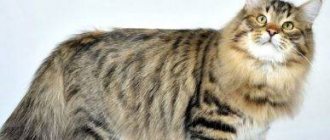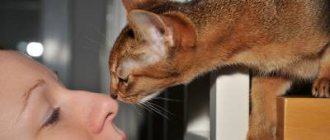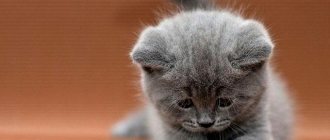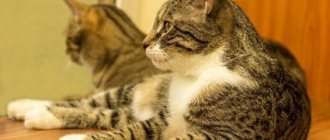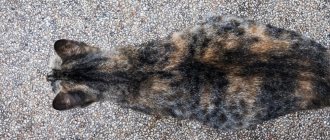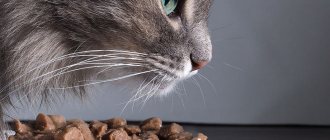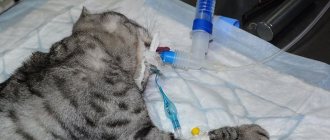We all know from childhood that the cat is the main enemy of the mouse. But in real life, not every mouse is ready to catch a mouse. Domesticated animals are often afraid of rodents and do not know what to do with them. And they have no desire to change their usual diet.
Each kitten acquires the skill of catching mice from its mother cat. If she taught him this vital activity, then in the future an adult animal will be able to catch rodents for food without any problems. But such a skill can only be imparted by homeless or village cats who themselves go hunting every day.
Cats have long helped humans in the fight against mice and rats, for which they were held in high esteem in Ancient Egypt and Rus'. It is believed that the ancestors of this animal themselves came to humans, after which they were domesticated, but to this day they have retained their independence.
A well-fed city cat is not inclined to catch, but the hunting instinct lives inside it. Therefore, under favorable circumstances, it may well become a “thunderstorm of mice.” Just before you start learning, there are a few things to consider.
Cat breed
The debate about which cat breeds are better at catching mice continues to this day. In fact, each of them has a hunting instinct, even the most pampered Persian beauty. The simple fact is that some animals manage to train their skill, while others, due to lack of practice, have long lost it. Thus, it is believed that Siamese, Bengal and Siberian cats, British Shorthairs and Maine Coons make good mousecatchers. But still, not every owner will decide on such experiments, because purebred animals require special care and feeding.
The palm belongs to outbred cats, which are often forced to catch mice for the sake of survival. They successfully pass on their hunting skills to the next generations, which is why many summer residents prefer to keep ordinary muroks. Many of them “walk on their own” in search of food, and only come home to sleep. Urban mongrel cats are also not averse to hunting. However, they will not always eat rodents. They much prefer to leave dead mice and rats under doors or hide them in their shoes.
If you want to have a ready-made mousecatcher cat, look for a kitten in the village. Just remember to check your pet's health with a veterinarian.
Hunting instinct in cats
Despite their small size and very long stay as pets, cats remain predators. The ancestors of modern cats were good hunters, because this was the only way they could get food for themselves and their offspring, and therefore survive and raise their cubs. The hunting instinct remains one of the main ones in cats to this day. By the way, this is exactly what appears in a small kitten chasing a toy.
Hunting
Gender of the animal
It is believed that females are more prone to catching mice than males. The fact is that cats have a highly developed sexual instinct, which sometimes prevents them from fulfilling their hunting duties. But the cat, on the contrary, is more inclined to hunt, because She has a nature to feed her offspring in the future. Of course, during estrus, the pet is unlikely to think about mice, but this period does not last long, and soon the cat is ready for exploits again.
In general, animals of both sexes will be able to catch mice, it’s just that males will do it more for fun, and females, even sterilized, will obey the survival instinct.
The meaning of appearance and the main characteristics of a hunter
At first glance, it is very difficult to determine how good a cat is at catching mice. But experts have identified several signs that indicate a successful hunter:
- muscular body;
- strong paws;
- powerful jaws;
- the outline of the skull resembles a triangle;
- ears are high, with tassels;
- bushy mustache;
- variegated coloring;
- short hair.
In addition, the cat must be active and have a good appetite. It is clear that it is almost impossible to detect the totality of all signs in one cat. But it is precisely these qualities that you should pay attention to when choosing a kitten that will catch mice.
Cat health
Only healthy and active cats can catch mice. If the animal has undergone castration or sterilization, then its hunting instinct will be preserved, but the desire to stretch its legs and catch a mouse may be very weak. To preserve it, do not overfeed your pet. This will also protect him from various diseases in the future. Encourage your animal to lead an active lifestyle, buy him a sports development complex or walk him more often.
Some summer residents are sure that in order for a cat to catch mice, you need to deny it homemade food. As a result, a hungry animal will be forced to go hunting. But in fact this is a misconception! Well-fed and happy cats also catch and kill mice, they just don’t eat them. But hungry people are often impatient and may not be the most successful hunters, especially if they have not caught rodents before. Denying food can ruin your relationship with your pet: it will get scared and harbor resentment. Therefore, we advise you not to starve your cat, it is cruel. As a last resort, you can slightly limit its diet, but only if the pet is completely healthy.
Why does a cat find no interest in hunting?
The cat, although it is a domestic animal, remains a predator by nature. She must get her food by hunting, for example, by catching mice. However, any instinct must be reinforced in practice, otherwise it fades. If for several generations an animal has not been required to perform this type of activity, it simply loses its natural skills. When a cat's day consists of sleep, balanced and tasty meals, and slow walking around the apartment, she has no need to go hunting. Thus, the first reason is elementary laziness, which develops quickly and for a long time in cats. The look of such animals is slow and calm, their movements are smooth and graceful, and their paws are not strong.
Since the time the industry began to offer healthy cat food, the need to feed live food has disappeared. All nutritional components come from an artificial product with a balanced composition, including separately for kittens. Feed contains vitamins and microelements, biologically active substances, proteins, fats, carbohydrates. This is often enough for the full functioning of the body and a decent appearance. This is reason number two.
Thirdly, the artificial breeding of prestigious breeds led to genetic mutations, during which the hunting gene gradually weakened. Therefore, breeds bred through selective breeding almost never know how to catch mice.
The fourth reason, which many put in first place, is the basic lack of hunger. A well-fed animal is content with its condition and does not see the need to run after mice. It is difficult to stir him up, much less make him run after rodents.
Mice health
Catching mice and rats is a definite risk to your cat's health. Rodents are often carriers of various diseases and parasites. In addition, they are often poisoned with poisons, which can lead to the death of the pet. If an animal eats whole rodents, then the likelihood of infection with dangerous diseases such as rabies, leptospirosis, salmonellosis, etc. increases. Therefore, the health of the mousecatcher must be kept under strict control: timely treatment for fleas and worms, and the necessary vaccinations.
So, we hope you have decided whether to teach your cat to catch mice. If the answer is yes, let's look at how this can be done.
Be prepared for the fact that, despite all your attempts, the animal will remain indifferent to the hunt. Cats have very different personalities and not all are suited to the task at hand.
Stages of training
Having decided to train, you need to have patience and endurance, prepare the necessary details, and also allocate a time and place where no one will interfere. The stages are as follows:
- Prepare a dummy mouse. It is desirable that it be soft, mobile, accompanied by sound. By launching it, the goal is to arouse a keen interest in the cat to catch up, grab it and hold it tightly with its claws. Some cats, tempted by such actions, begin to catch real mice, but do not eat them. They are perceived by them as a positive result of their hunt or just a toy. But it is not important. The main thing is to develop a taste for hunting.
- Develop a training plan for developing habits and running skills: place the cat in the center of the room, using movements of a tethered mouse of varying amplitude and speed to try to arouse its keen interest. First, the cat’s eyes “light up”, it focuses its gaze on the target, then freezes and takes aim. The final stage – the jump – is sharp and rapid. The exercise is repeated several times with the bait placed from different sides and at different distances. The more the cat fails, the more angry she will be and try to achieve her goal.
- If the previous stage begins to have results, the task should be complicated. The cat must understand that the mouse does not run in a straight line. It moves chaotically, turning sharply and changing its trajectory. This is what needs to be staged, for which purpose, put obstacles and barriers along the route, and arrange hard-to-reach places. On the obstacles themselves, you can increase the animal's interest by tying a piece of her favorite treat to a thread. Please note: in order to “help” the cat catch the mouse, you need to train in the place where it is supposed to move. Movement along familiar routes is always faster, faster, and more effective.
- Sound stimulation training. During training, you can develop the instinct of hunting by sound. By downloading a live mouse squeak on the Internet and playing it in different corners of the room, you need to make the cat perceive this sound as a signal to hunt. When he understands this, it is necessary to encourage the hunter. This type of training is called bearing.
- An important condition for successful training is the general physical fitness of the cat. Laziness should not be allowed to develop in him. Let him move more, jump for food or a toy, sharpen his claws and teeth. It should not be overfed and brought to excess weight. Apart from problems with digestion and the musculoskeletal system, this will not cause anything.
The described training will definitely give a positive result if carried out regularly, under the same conditions, with similar words. At this moment there is no need to scold the animal. Perhaps the situation is so advanced that it simply does not understand what they want from it. Then it will take more effort. If the owner’s patience runs out before the ward learns to catch, the rodents in the house will have to be caught with a mousetrap.
It is possible that some felines will never have the desire to independently grab a live mouse with their claws. But it's still worth a try. After all, this instinct is inherent in nature itself.
How to teach a cat to catch mice - step by step instructions
It is best to teach a kitten to catch mice. But you can teach this to an adult cat. The scheme will be approximately the same.
- Catch the mouse yourself and show it to the cat. Give your pet the opportunity to look, smell, and play with the rodent. For the first acquaintance, you can use a dead mouse. It is important that at this stage the cat learns who she will have to deal with in the future.
- Carry out a series of active games with a dummy mouse that is as close as possible to a real rodent. Tie it to a rope and give the cat the opportunity to “hunt”. At the same time, develop your pet’s dexterity, because mice are very sneaky animals. Using bait, train your cat to overcome various obstacles. You can do this in places where you often encounter rodents. Just remember to keep your cat safe.
- Provide your cat with a scratching post so she can keep her claws ready, and regularly provide dry food or large pieces of meat to self-clean her teeth and keep them sharp.
If a cat becomes interested in mice, then perhaps she will soon awaken a desire to catch one of the individuals as a gift for you.
How to let your cat know what is expected of him
If it is important for the owner for the cat to fulfill its direct natural purpose, it is worth trying to teach it to be a hunter.
Advice from experienced people contains different sequences of actions. The first ones recommend starting with developing a feeling of hunger. By keeping the animal on a “starvation diet” for some time, you can provoke it to go in search of food on its own.
Other experts recommend starting with developing the skills of agility, swiftness, attentiveness and tenacity. When a cat feels strong, she will become interested and want to show it in hunting. For training, you can use an artificial mouse, which you can quietly pull on a string, teasing and captivating the future hunter. You can pick up a live mouse that is not the first freshness, for example, the one that the neighbor’s cat caught.
According to others, the instinct to catch mice should be developed through stimulation. For each mouse caught, the animal should receive some kind of reward (a treat, a favorite pastime, a toy, etc.). Then he will have a natural interest in a process that promises new pleasures.
Finally, the fifth group of “cat experts” is of the opinion that the cat is an extremely intelligent animal. It always understands what is expected of it, but it doesn’t always want to do it. If you praise her, please her in every possible way, celebrate all her good deeds, but at the same time make it clear what is expected of her, she will definitely thank her for her kind attitude with caught living creatures.
There is an opinion that it is easier for cats to develop the instinct to catch mice than for cats. This is due to the inherent nature of the female individual’s responsibility for caring for offspring. The need to feed the kitten will help the cat understand how to obtain natural food.
How to react to the owner
Having understood the reasons why the cat brings mice to the owner, it is necessary to develop the correct behavior in such a situation. First of all, you should not scold or show negative emotions at the sight of a dead bird or mouse, as if
the spectacle did not look terrible.
If a pet, which had the best intentions of feeding or teaching its owner to hunt, is scolded, punished or shown displeasure, this can cause a feeling of mistrust and alienation in the animal.
If you find a dead rodent, bird or other trophy in your home, household members should not panic. As a rule, the prey is already dead and poses no threat. If a hunting trophy shows signs of life, then measures must be taken to kill it safely.
In order not to offend your pet with your inattention, you should thank the animal for the trust shown, caress it and, if possible, remove it to another room. The carcass must be placed in a plastic bag and, sealed tightly, thrown into a trash can. You must wear gloves and then wash your hands thoroughly with soap. The cat should not be present during this manipulation, otherwise it will lose trust and disposition towards its beloved owner.
Recommendations
A hunting cat spends a lot of time outdoors, in contact with other animals, which increases the likelihood of infection and the development of diseases. To protect your pet from diseases, you need to remember the following rules:
- the cat must be periodically vaccinated against potential diseases;
- the pet needs to be fully fed and fortified with vitamin supplements, which will strengthen the immune system;
- every 5 months, clean your pet of worms for the purpose of prevention;
- the animal needs to buy a flea collar that prevents the spread of parasites;
- in early spring, before a walk, it is recommended to treat your pet’s fur with protective sprays, since in May the likelihood of insect attacks increases.
For preventative purposes, you can take your cat to the veterinarian for examination once every six months.
The cat sleeps, but sees all the mice (proverb)
Because of the hunter’s attachment to the house, many owners are faced with the problem: “Why do cats bring mice to the doorstep, to the owner’s bed, to the kitchen?” Finding a dead or half-dead rodent is not very pleasant. But animal psychologists recommend treating this phenomenon calmly, without scolding the cat or throwing away this unique gift in front of her eyes. If your pet brought a mouse and defiantly laid it on the floor at your feet, this speaks of strong affection and love: “Here, eat. You’re clumsy, strange, you don’t have a tail - you’ll never be able to catch it yourself.”
There are other reasons why cats bring mice. One of them is banal practicality: “What if tomorrow you won’t be able to catch prey?” The second is the desire to play with the mouse later, after completing more important tasks known to one cat. And the third is uncertainty: “I’ll play here, otherwise there are plenty of other cats on the street, they’ll take more of them.” In any case, the more acutely the owner reacts to this behavior, the more often the cat will bring prey into the house. It’s better to quietly throw the rodent out or take it outside the threshold and defiantly put it somewhere nearby: “Store it here, no one will touch it!”
Who is the best hunter - a cat or a cat?
Who is better at catching rodents - a male or a female? It is believed that the best rat hunters come from stray cats. Maternal instinct forces the female to hunt, and the cat hones her skills to perfection.
Males are not as active as cats. Their main task is procreation; for this, the cat needs to interest and attract the female. However, a cat deprived of food, forced to rely only on itself to solve the “food issue,” is guided by instinct and becomes an excellent hunter.
Cats hunt mice and rats most actively about once a quarter, before the approach of estrus. Consequently, about 3-4 times a year, a pet can clear a house or apartment of uninvited guests. The best candidate for the position of mouser is considered to be a cat.
Catching mice, ways to train a cat
Despite the fact that all cats should catch mice, because it is inherent in them at the genetic level, there are those who do not want to do this, do not like and are even afraid of mice. To train a cat to catch mice, you need to do certain things.
In order for you to succeed, you need to take any toys, especially those that the cat likes most, and tie them to a fishing rod or similar device. Be sure to take treats with which you will reward your pet for a job well done. All these activities will be carried out so that your cat learns to catch mice, listens to its instincts, and, in addition, receives daily physical activity, which is important for any animal, especially a domestic one.
Now we will take a closer look at how to teach a cat to catch mice:
- The first thing to do is to find a toy in the shape of a mouse so that the cat’s external image of it is fixed. In order for the animal to more actively come into contact with the toy, it needs to be slightly moistened with catnip, which attracts cats. It is this kind of device that will allow the pet to learn to play with such an object. Under natural conditions, a mother cat teaches her kittens how to hunt in a completely different way: she immediately brings them a completely dead mouse, then one that is still alive, but seriously injured, and then teaches them to hunt and crush mice by example. A kitten who has been able to find, catch and kill a mouse at least once will never forget this skill. If the cat is domestic and grew up without parents, there is no place for him to take an example, so a person must help him. The learning algorithm will be exactly the same as for mother cats, so you will need to find live mice and introduce your cat to them in the same order. Preliminary games with a toy mouse will be the first step to raising a hunter.
- When the cat is interested in the toy, you must definitely pay attention to this, praise it well and treat it with a treat.
- After this stage, the toy must be tied to a fishing rod or similar device. The toy remains on the floor and is pulled along the floor using a fishing rod. The cat needs to be called so that it pays attention to what is happening around it.
- When moving a toy across the floor, it is important to make abrupt and unexpected movements so that the cat becomes interested in this object and pays all its attention to it. A toy that also smells like catnip will arouse genuine interest in your pet. It is very important to note any actions of the cat, praise him and treat him with tasty treats.
- Once you have taught your cat to handle a toy mouse inside the house, it is important to change the environment and go outside into a more natural environment for the animal. The game does not change in its essence, the toy still drags along the ground, but now the grass and various buildings interfere with the cat, making it much more difficult to navigate and catch the object. The pace at which you need to drag the mouse should be such that the cat has time to react, but the task is feasible for him. It is important to let the pet get to the prey and catch it in its paws, in order to feel within itself that very hunter whom the owner seeks to awaken. As soon as the cat reaches the mouse and grabs it, it is important to pull the rope to simulate the mouse’s attempts to escape from the cat’s clutches. Such games will help the cat adapt to the behavior of its future prey, and it will be ready for it. At this stage, the pet is also treated to something tasty for the successful actions taken.
- With each training session, it is important to reduce the time when the mouse is motionless, so that the cat learns to react and attack the target faster. As soon as the prey is caught, you must praise the cat. As soon as such games become familiar, normal and easy for the cat, you should introduce him to real mice, using the example of the cat’s mother, and only after that let him go fishing. At first, it is important to support the cat, praise him for victories and caught mice, and reassure him if the hunt is unsuccessful. After several successful exits, your cat will definitely be able to become a real predator in terms of chasing mice, and the goal will be achieved.
From the above exercises it follows that almost any cat can be taught to hunt mice if you have the desire and opportunity. If a cat lives in a private house and constantly deals with other cats, he will learn to hunt himself, simply by what he sees every day. If your cat has given birth to kittens, she will train them herself and easily teach them how to get tasty little mice for dinner. If you do not have such conditions, and the cat lives in an enclosed space, but you still want him to have the instincts of a hunter and be able to catch a mouse if necessary, then you need to take care of his upbringing personally. There may be several methods and variations, the main thing is to understand the main thing, the cat must understand what a mouse looks like and how it can move and behave. To interest him, the training object must be soaked in catnip. It is best to choose a toy that is as similar as possible to a real mouse to visualize the cat's prey. This period will not cause much difficulty for both you and the cat, but if you decide to continue and introduce your pet to real mice, then this part of the training will not be pleasant, because having a dead mouse in your house , in itself is unpleasant. However, after suffering only a few times, you will achieve the awakening of hunting instincts from your pet, and as soon as he sees the target, he will overtake it and deal with it, of which you can be absolutely sure.
How to make a cat catch a mouse
Only then will you be able to sleep peacefully.
1. Getting to know the subject of the hunt
Borrow a mouse from a neighbor. Of course, you can catch the mouse yourself, but it will be easier if a neighbor does it. By releasing the mouse in front of the cat's nose, get the cat interested. Let the cat feel that the mouse is not a scary animal. The main goal of the exercise is to set up the cat’s target recognition systems and its (target) tracking.
2. Dummy mouse
Since a live mouse is a very nimble and unpredictable creature that is drawn to a mink, it will be difficult to train a young cat on a live mouse. You're not eager to pick it out from under the sofa every five minutes, are you? Therefore, to train a cat's hunting skills, you can use a gray and fluffy dummy mouse tied to a very thin thread or fishing line.
3. Learning basic hunting movements
Study the habits and running movements of a mouse using the encyclopedia. Place the cat in the center of the room and, by manipulating the speed and course of the mouse, achieve stable conditioned reflexes of the cat to the mouse. Remember that the main stages of hunting are: lying in wait for a target, sneaking up and attacking from different positions. Your task is made easier by the fact that a cat that is not completely well-fed reacts well to a small moving object, such as a bow, lace or a ball of wool.
4. Steeplechase and hurdles
Since a natural mouse does not express a desire to run straight, evenly and in open areas, but expresses a desire to run in hard-to-reach places (through holes, under a sofa, and a closet), it is necessary to train the cat to quickly force through any obstacles. To do this, tie a piece of delicious sausage to a string and pull a piece of this sausage over the obstacles. Don’t forget to periodically give a piece of sausage to your cat to eat. And don’t lure your cat to places where you can’t get him out manually if he gets stuck.
5. Pursuit routes
Practice shows that hunting is most successful when the cat moves along familiar places and routes. In this case, the running speed and the speed of overcoming obstacles will be maximum. Therefore, you should calculate all the routes along which the mouse will move (and, if necessary, lay them yourself), and, using a dummy, do several training marches.
6. Working by bearing
Because your cat has two ears, he can turn his head to determine where a sound is coming from (this is called “binocular hearing”). So that the cat can confidently distinguish the rustling and squeaking of a mouse among other noises, place sources of mouse noise in different nooks and crannies of the room. By turning them on in random order, get the cat to have a stable bearing of the suspicious sound.
7. General physical training
Don't let the cat lie around and sleep! Develop his running skills and long and high jumping skills (but remember that cats, unfortunately, do not pole vault). Provide your cat with a place where he can sharpen his claws and teeth.
8. Mouse in paws
If your cat has caught a mouse, but doesn’t know what to do with it, teach him to hook with his left and right paws. This will give the mouse hunt the finishing touch and logical completion.
Happy hunting to your cat!
How to teach a cat to catch mice
Greenpeace people don't read it - a heart attack is guaranteed.
That was a long time ago. There are rats in our barn. The grandfather went to a friend whose cat had given birth and took a kitten to solve this problem. The future super rat catcher was named Vasily.
The kitten grew up, ate cottage cheese, drank home-made milk, caught flies at the window, but did not want to do what it was taken for - at least catch mice, not to mention rats. The mice caught in the mousetrap did not evoke any predatory instincts in the cat.
It was in the 50s, and my grandfather was a veteran of the Great Patriotic War and a rather stern man. When Vasya reached normal mouse-catching age, but showed no desire to do what he was taken for, my grandfather, unnoticed by my grandmother, locked the cat in the barn for the night, and according to available intelligence data there were, to put it mildly, a lot of rats there.
When he went out to smoke in the morning, the grandfather was slightly surprised - the beaten and crazy Vasily was sitting at the threshold of the house, with the tip of his ear chewed off, a broken tail, barely alive but alive! He didn’t even have the strength to meow in order to give a signal that I was a jerk. In order to avoid the inevitable ending of being eaten by barn rats, he managed to knock out one of the small glass windows! Granny gave a prescription to grandfather and began treating the cat. I don’t know the details of the treatment, but the cat recovered quickly enough - thank God the paws are intact and the stomach is not ripped open.
Peekaboo
And which cats are better at catching rats than others, based not on their breed, but on their appearance? It is believed that these are short-haired animals: in damp weather, long hair smells stronger, scaring away potential prey. In addition, the fur coat must be appropriately colored: dim stripes and spots are welcome, the so-called “wild” color, which helps the hunter to blend in with the terrain. If there is no pattern on the fur coat, calm, soft colors are preferable: a white cat has difficulty catching a mouse, but a red, gray or black one can hide more easily, using the features of the landscape. And, on the advice of our grandparents, choose the most whiskered kitten: the longer the whiskers, the more successful the hunt.
